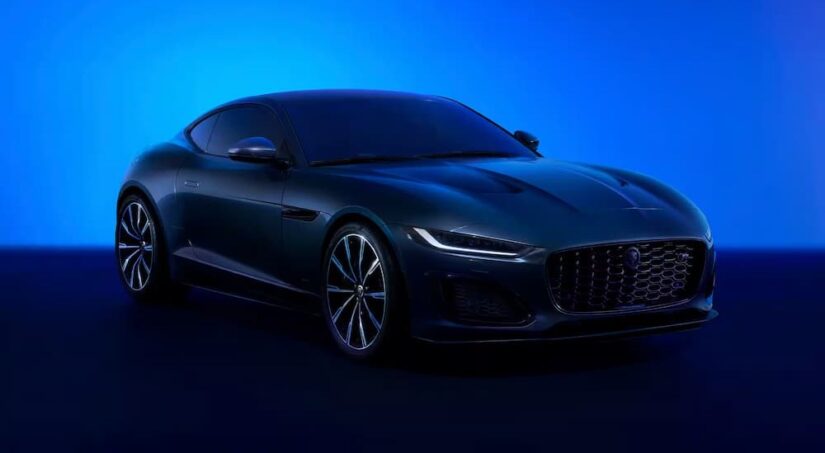There are some big changes afoot at Jaguar. In recent years, the luxury brand has played second fiddle to Land Rover in terms of both sales and the amount of attention it has received from its parent company. Jaguar moved just 43,000 units in 2022—a figure that’s dwarfed by Land Rover’s 280,000 sales over the same period. The difference is even starker in the US market, where Jaguar sales represented just 11% of JLR’s total volume. These numbers have led to more than a little soul-searching for Tata Motors, but the Indian company seems to have found a solution in electrification.
Jaguar will be “radically reimagined as an all-electric luxury brand by 2025,” according to a recent statement by the company, with three new EVs set to debut in the coming years. It all starts with a four-door GT that’s expected to go on sale in late 2024. That will be followed by a forthcoming luxury SUV and large sedan, which will share the GT’s new Jaguar Electric Architecture (JEA) electric platform. With the GT, Jaguar looks to be following the same game plan as its Land Rover sibling, which is about to unveil the first all-electric Range Rover model later this year.
The move toward electrification is certainly nothing in today’s auto market, but Jaguar isn’t taking any half-steps when it comes to its own EV push. Earlier this year the company announced that Jaguar will sunset all gas and hybrid models within the foreseeable future. Production of the XE, XF, and F-Type will end in June 2024, while the E-Pace will get the axe toward the end of the year.
Oddly, Jaguar will also cease production of its sole EV offering, the I-Pace crossover SUV, around the same time. Jaguar reports that production of the best-selling F-Pace compact crossover will continue for the foreseeable future and says it’ll keep dealers stocked with inventory until the end of 2024, but Jaguar as we know it could be coming to an end. So how did we get here, and when can drivers expect to get behind the wheel of a new, all-electric Jaguar model? We’ll answer all those questions and more as we catch up with the luxury segment’s favorite jungle cat.
Jaguar Cleaves Itself Off
Jaguar has changed hands plenty of times since it was first founded more than a hundred years ago as the Swallow Sidecar Company. While the company was independent for its first forty-plus years, Jaguar eventually merged with British Motor Corporation (BMC) in 1965. Ford would take its turn around the turn of the millennium when it went on a buying spree that also included the acquisition of Aston Martin, Volvo, and Land Rover. Tata Motors—an Indian multinational best known for its buses, trucks, and vans—would win the rights to Jaguar in 2008 when it paid $1.7 million for both the Jaguar and Land Rover brands. The two would merge in 2013, forming the joint marquee of Jaguar Land Rover.
Now, things are set to change yet again. In March of 2024, Jaguar Land Rover announced it would break the company up into four sub-brands: Range Rover, Jaguar, Defender, and Discovery. The first two represent well-established brands, while the latter will see two of Land Rover’s current models—the midsize Discovery SUV and luxury off-road Defender—spun off as Tata works to maximize profitability.
“This demerger will help them better capitalize on the opportunities provided by the market by enhancing their focus and agility,” said N Chandrasekaran, chairman of Tata Motors. “This will lead to a superior experience for our customers, better growth prospects for our employees, and enhanced value for our shareholders.”
Tata has already made a substantial investment in electrification, dropping some $18.6 billion to retool its UK factories. Some of the funds will also go toward the development of new vehicle programs, autonomous production, AI, and other digital technology in a spending spree that Tata hopes will set the brands up for future success. The investment already looks to have paid off in the short term, with Land Rover announcing an estimated 16,000 reservations for its forthcoming Range Rover Electric luxury SUV.
Plugging Into a New Era
So, what do we know about the upcoming all-electric Jaguar GT? This electric jungle cat is still slinking through the dense underbrush of development, making it difficult to get a clear look, but early reports do shed light on a few important details. Like all of the forthcoming JEA models, the four-door GT will come standard with four-wheel drive.
A spiritual successor to the current XJ full-size sedan, the GT is also designed with four-wheel steering, which confers some real benefits in cornering, stability, and control. That sense of control will come in handy when you’re putting the GT through its paces and trying to take advantage of the over-450 hp that’ll supposedly be on offer from the dual electric motors. With a reported zero-to-sixty time of between 3.0 and 3.8 seconds, the GT should more than live up to the thrilling, gas-powered Jags of old.
Of course, performance is only half the equation when it comes to EVs. All the power in the world won’t do you much good if you find yourself on the side of the road with a dead battery, but Jaguar seems to have its bases covered. The company says the GT will have a range of between 385 and 475 miles, which would place it near the top of the heap in today’s luxury EV segment.
In fact, the GT would best all its likely competitors, offering greater range than the Tesla Model S (302 miles), Porsche Taycan (246 miles), Audi e-tron GT (238 miles), and BMW i7 (321 miles). Out of today’s current luxury sedan offerings, the GT’s closest rival would be the Mercedes-Benz EQS at 352 miles, but the Jaguar would still surpass it by some 30 miles even when looking at some of the most conservative range estimates.
Best of all, the GT is said to charge from 10-80% in just 13 minutes. That rapid charging time is an especially important factor in the luxury segment, where drivers are accustomed to getting their way. All the GT’s luxury features and performance perks don’t amount to much when the vehicle is queuing up at the neighborhood fast-charger, but Jaguar will keep these visits mercifully short for their new EV sedan.
Naturally, that sort of convenience comes at a price. The Jaguar EV will start for around $127,000, with Tata probably hoping that the high price will make up for the brand’s historically low sales volume. The GT will be revealed toward the end of the year and go on sale in early 2025, according to a number of industry sources.
While Jaguar has been forthcoming with details surrounding the GT, the other two JEA-based models are still a bit murky. The first, an all-electric luxury SUV, will be comparable in size to the full-size Bentley Bentayga, while the EV sedan will share similar dimensions with Bentley’s Mulsanne full-size car. While we’ve yet to see any concrete renderings, the new Jaguar EVs will reportedly share a modern, minimalist style.
One surprising casualty of this new design approach is the rear window, which will be replaced with a rearview camera. The iconic pouncing Jaguar emblem will also meet its end with the brand opting for new “JAGUAR” lettering across the grille. The EV models will all be introduced one year apart, so it could take until 2027 to see the full lineup come to fruition.
Drivers looking to enjoy the last days of Jaguar’s gas-powered era should get a move on. JLR boss Adrian Mardell says that all of the brand’s current models will disappear from dealerships by the time the GT hits the market in 2025. “When we launch our new JEA platform, the change from today on Jaguar is very dramatic,” said Mardell. “We don’t want older-looking cars and newer-looking cars.”
Becoming Its Own Thing Again
Jaguar has never been a huge seller in terms of pure volume, but it has developed a loyal customer base who appreciate the brand’s luxury-first approach. Whether these drivers will stick by as the brand embraces electrification remains to be seen. While there are sure to be some holdouts who prefer the raw power and guttural roar of a good old-fashioned gas-powered engine, Jaguar really doesn’t have that much to fear as fewer and fewer such models exist with every passing year.
As long as Jaguar can prove that the performance and luxury credentials of these new EV models will stand up to customers’ lofty expectations, it should all be smooth sailing. Performance surely won’t be the sticking point (the forthcoming GT is said to be the most powerful Jag ever produced), though the high cost of entry might turn away some drivers who don’t have $100,000+ to spend. Only time will tell what the future holds for Jaguar, but this legacy brand certainly looks to be setting itself up for success with its latest move.



